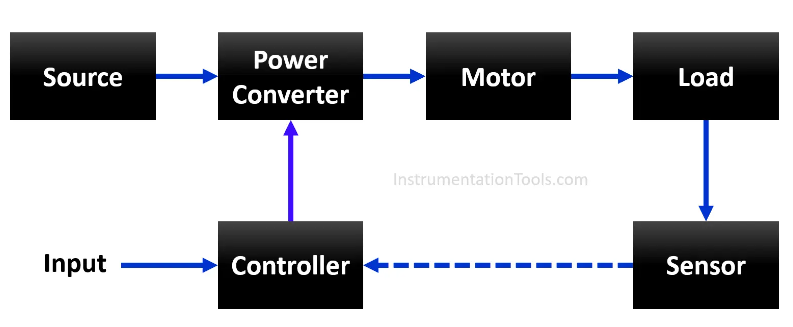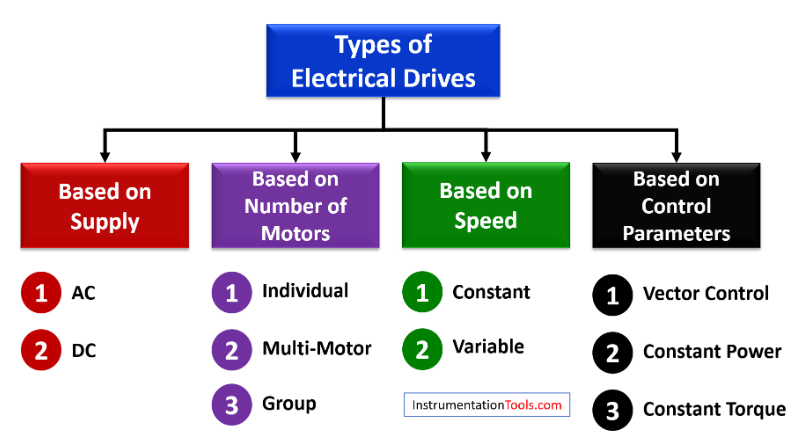- An electrical drive is defined as an electronic device designed to control certain parameters of the motor for controlling the electrical energy into mechanical power in a precise controllable way.
- Electrical power systems employed for motion control are called “Electrical Drives”.
- It consists of a sophisticated electronic system or a combination of different systems for motion control.
- Motion is provided with the help of prime movers.
- Example of prime movers are Petrol engines, Diesel engines, gas or steam turbines, steam engines, hydraulic motors, and electric motors.
- Driver power systems employing electric motors are known as electric drives.
Block Diagram of Electrical Drive
A modern electrical drive capable of variable controlled speed is made of some important parts as shown in the below block diagram.

Source: Source can be DC or AC source.
Power converter: AC to DC, AC to AC, DC to DC, DC to AC converters.
Motor: Converts electrical energy into mechanical energy, it is the heart of the electrical system.
Commonly used motors are
- DC motors – series, shunt/parallel DC motor, compound and permanent magnet DC motor.
- Induction motors – wound rotor and linear, squirrel cage.
- Brush less dc motors
- Stepper motors.
Load: It can be a machine to accomplish a given task. Examples are Pump, Fan, Machine tools.
Controller: The power required for the motor is supplied by the controller.
Sensor: Depending upon the type of control required, various inputs from sensors are taken. An example is speed, current.
Types of Electrical Drives

Based on Supply
There are two types available in this category. They are
AC Motor drives
- AC drive is a device used to control the speed of an electric motor such as a three-phase induction motor by changing the frequency of the electrical supply to the motor.
- AC drive is also called Variable Frequency Drive (VFD) or Variable Speed Drive (VSD).
DC Motor drives
- It is basically the speeding control system of a DC electrical motor that supplies voltage to the motor to operate at desired speed.
- DC drives are classified as analog DC drives and digital DC drives.
- Digital DC drive can offer precision control.
Based on Number of Motors
- There are three types available in this category. They are
Individual
- There will be a separate drive motor for various parts of a machine.
- Example: Lathe machine.
Multi Motor
- Separate motors are provided for actuating different parts of a machine.
- Example: Cranes.
Group Drive
- In a group drive, one motor is used as a drive for two or several machines.
- The motor is connected by a single shaft, other machines are connected to the shaft by belts and pulleys.
- Group drive is most economical.
Based on Speed
- There are two types available in this category. They are
Constant Speed drive
- Machine tools require constant speed drives, squirrel cage induction motor and manual controls are used.
Variable Speed drive
- The main purpose of variable speed drive is to control speed along with acceleration, deceleration, torque and finally the direction of machine.
- They are used to reduce power consumption.
Based on Control Parameters
- There are three types available in this category. They are
Vector Control Drive
- Vector control is more accurate than any other kind of variable frequency drive (VFD).
- In this control mode, torque and speed are controlled using pulse width modulation (PWM) techniques in an inverter.
- These are used for AC synchronous and induction motors.
Constant Power Drive
- When a motor, while carrying rated current in its armature, provides constant power at all speeds in a certain range of speed control it is known as constant power drive in that range of speed control.
Constant Torque Drive
- Constant torque load type drive is distinctive when fixed volumes are being handled.
- Examples are screw compressors, feeders, and conveyors.
Advantages of Electrical Drives
- Enough overload capacity without loss of life of machine.
- Four quadrant operation.
- Modifiable torque-speed characteristics.
- No requirement of warming up period.
- Higher efficiency.
- Easy control.
- Clean operation, no pollution.
- Wide range of speed control.
- They have flexible control characteristics.
- Electric braking can be employed
- Electric drives can be provided with automatic fault detection systems.
- Electric motors have long life lower noise, lower maintenance requirements and cleaner operation
- Adoptable to almost an operating condition such as explosive and radioactive, submerged in liquids etc.
- They can be started instantly and immediately can be fully loaded.
Disadvantages of Electrical Drives
- High initial cost due to the presence of power converters and controller electronics.
- Regular maintenance and high attention are required.
Applications of Electrical Drives
Extensively used in
- Industrial production,
- manufacturing, and
- process control.